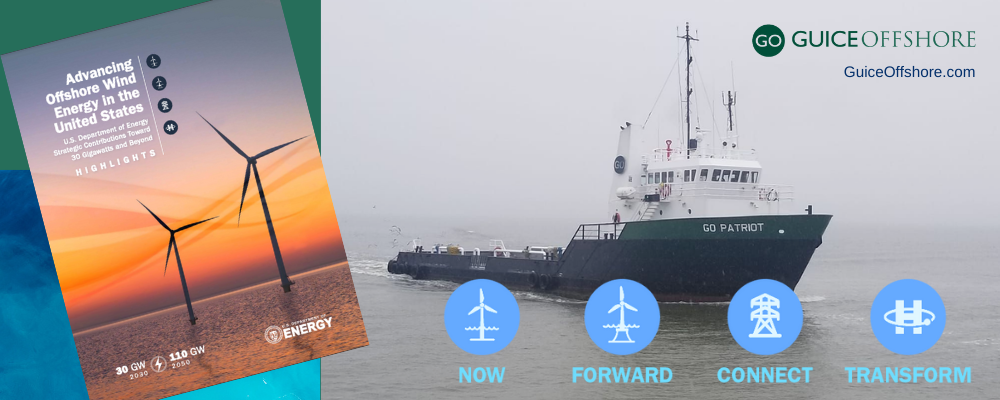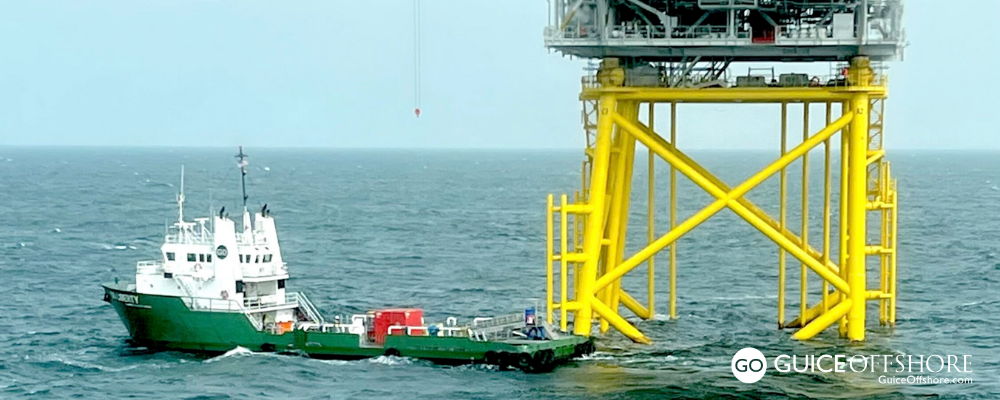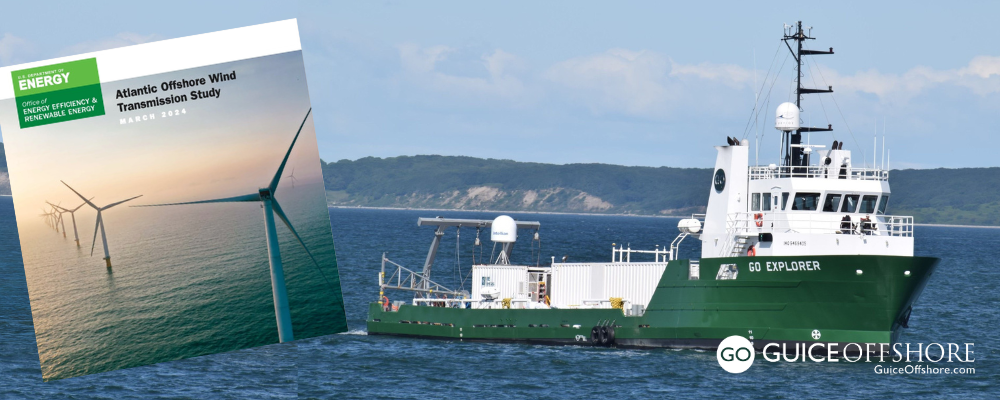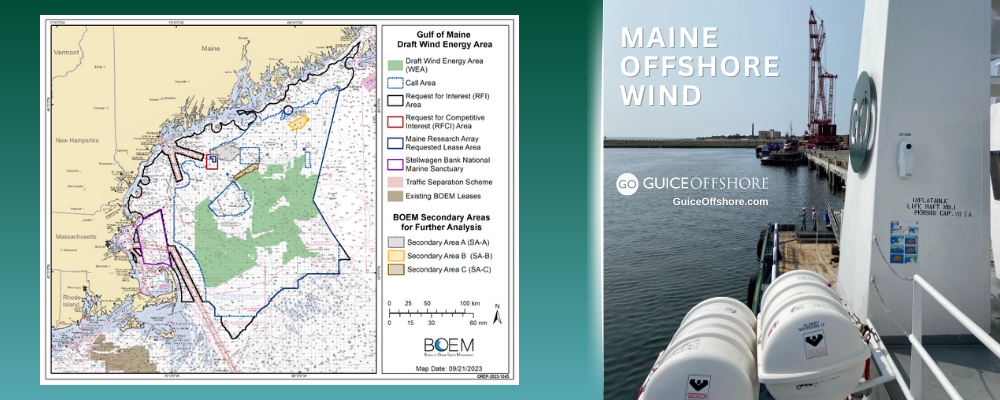As the Business Network for Offshore Wind’s International Partnering Forum is in full swing today, March 29, 2023, offshore supply vessel provider Guice Offshore notes that the U.S. Department of Energy (DOE) concurrently announced the release of its Offshore Wind Energy Strategy, a first-of-its-kind, comprehensive summary of the DOE’s efforts to meet the federal government’s goal to deploy 30 gigawatts (GW) of offshore wind energy by 2030 and set the nation on a pathway to 110 GW or more by 2050.
- Click here to download the full report: Advancing Offshore Wind Energy in the United States Highlights
Deploying 30 GW of offshore wind would provide enough power for 10 million homes, support 77,000 jobs, and spur $12 billion per year in direct private investment. The DOE-wide strategy outlines how the agency will support a whole-of-government approach to accelerate the deployment of offshore wind in support of achieving a carbon-free electricity sector by 2035.
This Strategy also supports the goal of deploying 15 GW of floating offshore wind and achieve a carbon-free electricity sector by 2035.
“As our Offshore Wind Energy Strategy shows, we’re leveraging all of the key resources across our department to harness this clean and reliable American energy source, which will create tens of thousands of good-paying, union jobs and revitalize coastal communities. This strategy will significantly drive down America’s carbon emissions, establishing America as a leader in floating offshore wind technologies,” U.S. Secretary of Energy Jennifer M. Granholm said.
Offshore wind is rapidly growing around the world, becoming a central part of international decarbonization and a vital part of coastal economies, and the domestic potential to harness offshore wind is now emerging. There are currently 40 GW of offshore wind in various stages of development, which suggests the potential for substantial expansion.
The strategy released by the DOE today categorizes America’s offshore wind efforts into four pillars:
- NOW: Lower costs from $73 per megawatt-hour (MWh) to $51 per MWh by 2030, develop a domestic supply chain, and inform sustainable, just deployment of fixed-bottom offshore wind.
- FORWARD: Achieve the Floating Offshore Wind Shot goal of reducing cost by over 70% to $45/MWh by 2035, establish U.S. leadership in floating offshore wind design and manufacturing, and inform sustainable, just deployment of floating offshore wind.
- CONNECT: Enable reliable and resilient transmission solutions for large-scale offshore wind deployment.
- TRANSFORM: Expand offshore wind co-generation technologies for widespread electrification and decarbonization.
Collectively these four pillars seek to support offshore wind development in a manner that is economic, just, and environmentally sustainable.
For decades, DOE’s Wind Energy Technologies Office (WETO) investments in research and development have supported the technological advances that helped commercialize wind energy production in the United States.
Additionally, the Department’s work spans technical assistance, community engagement, demonstration projects, transmission planning, loan guarantees, manufacturing research, supply chain and workforce development, environmental research and more.
The DOE Offshore Wind Strategy helps connect work happening at WETO and across 15 other DOE offices with specific roles in achieving America’s offshore wind goals and continuing our transition to a clean energy economy.
Department of Energy Offshore Wind Energy Strategic Initiatives
The Strategy divides DOE’s offshore wind efforts into four pillars:

Near-Term Offshore Wind (NOW)
- Reduce the cost of fixed-bottom offshore wind to $51/megawatt-hour (MWh) by 2030.
- Support the development of a robust domestic offshore wind supply chain to install and operate more than 30 GW of fixed-bottom offshore wind.
- Inform just, sustainable, and timely development of fixed-bottom offshore wind.
Floating Offshore Wind Accelerated Research and Development (FORWARD)
- Achieve the Floating Offshore Wind Shot goal of reducing the cost of floating offshore wind energy in deep waters far from shore to $45/MWh by 2035.
- Support the development of a domestic supply chain to facilitate deployment of 15 GW of floating offshore wind by 2035.
- Inform just, sustainable, and timely development of floating offshore wind energy in deep waters.
CONNECT
- Coordinate and inform planning for a transmission system that integrates offshore wind energy with the U.S. electricity grid.
- Support technology innovation to increase offshore grid reliability, resilience, and interoperability.
- Support expansion of reliable and resilient grid infrastructure.
TRANSFORM
- Promote storage and wind-to-fuel technologies from offshore wind energy.
- Support the development of offshore wind energy hubs.
All-of-DOE Approach
DOE seeks to build on the expertise, capabilities, and resources across a range of its offices to promote offshore wind energy. This strategy identifies the many opportunities for DOE action, including the many offices that might engage in the focus areas of this strategy.
These areas include R&D to lower costs; efforts to promote just, sustainable, and timely deployment; transmission research and coordination; stakeholder engagement; supply chain development; and many other key facets of offshore wind energy deployment. Each office contributes to one or more critical areas of need.
| NOW | FORWARD | CONNECT | TRANSFORM | |||||
|---|---|---|---|---|---|---|---|---|
| COST REDUCTIONS | DOMESTIC SUPPLY CHAIN DEVELOPMENT | EXPANDED, JUST AND SUSTAINABLE DEPLOYMENT | COST REDUCTIONS | DOMESTIC SUPPLY CHAIN DEVELOPMENT | EXPANDED, JUST AND SUSTAINABLE DEPLOYMENT | TRANSMISSION DEVELOPMENT | CO-GENERATION APPLICATIONS | |
| Advanced Materials and Manufacturing Technologies Office |
• |
• |
• |
• |
• |
• |
||
| ARPA-E |
• |
• |
• |
• |
||||
| Grid Deployment Office |
• |
• |
||||||
| Hydrogen and Fuel Cells Technologies Office |
• |
• |
• |
|||||
| Loan Programs Office |
• |
• |
• |
• |
• |
• |
• |
• |
| Office of Clean Energy Demonstrations |
• |
• |
• |
• |
||||
| Office of Cybersecurity, Energy Security, and Emergency Response |
• |
|||||||
| Office of Economic Impact and Diversity |
• |
• |
• |
• |
• |
• |
||
| Office of Electricity |
• |
• |
||||||
| Office of Manufacturing and Energy Supply Chains |
• |
• |
• |
• |
• |
• |
||
| Office of Science |
• |
• |
||||||
| Vehicle Technologies Office |
• |
• |
||||||
| Water Power Technologies Office |
• |
• |
• |
• |
• |
• |
• |
|
| State and Community Energy Programs |
• |
• |
• |
• |
||||
| Wind Energy Technologies Office |
• |
• |
• |
• |
• |
• |
• |
• |
Click here to learn more about efforts by DOE’s WETO to accelerate and expand the deployment of wind energy in the United States.
Read the DOE Offshore Wind Energy Strategy here.
DOE Announces Winners in First Phase of Prize to Develop Floating Offshore Wind Supply Chains
The U.S. Department of Energy (DOE) today announced the Phase One winners of the FLoating Offshore Wind ReadINess (FLOWIN) Prize, a first-of-its-kind competition to tackle the floating offshore wind energy industry’s biggest supply chains challenges. About two-thirds of the nation’s offshore wind resource potential is in areas with water depths over 60 meters, where floating offshore wind turbines are more practical and cost effective than fixed-bottom turbines. The three-phase competition, which is open to floating wind platform designers, fabricators, and project site developers, aims to bridge manufacturing and logistics gaps to help meet the Biden administration’s goals to reduce the cost of floating offshore wind by 70% and deploy 15 gigawatts by 2035.
“The winning teams all demonstrated designs that are realistic and represent progress toward wide-scale, domestic floating offshore wind energy manufacturing and deployment in the United States,” said Alejandro Moreno, Acting Assistant Secretary for Energy Efficiency and Renewable Energy. “They help lay the foundation for a thriving domestic offshore wind energy industry, which can provide clean, renewable energy to millions of American households, support good paying jobs, and revitalize port communities.”
Each Phase One winner will receive $100,000 cash and $75,000 in vouchers for technical support provided by DOE national laboratories. In total, the FLOWIN Prize has a cash pool of $5.85 million, plus up to $1.175 million in technical support.
The nine winners of Phase One, which focused on determining critical manufacturing and supply chain challenges to the commercialization of floating turbine technology, are the following:
- Aikido Technologies (San Francisco, California): The Aikido design is a steel semi-submersible floating platform made of steel tubes that can be manufactured at tower facilities. The platform design offers a streamlined installation process because it can be transported in a unique, horizontal configuration and requires no welding during the final assembly process.
- Beridi USA (Spanish Fork, Utah): Beridi’s Triwind is a concrete-based floating platform that uses damping pools and buoyancy chambers to provide superior stability, limiting fatigue loading. The platform can be mass-manufactured at existing sea ports to provide cost savings.
- FloatHOME (Emeryville, California): FloatHOME’s triangular platform, WindFloat®, now in its fourth generation, provides deep-water stability through unique design features, including a damping system to absorb wave excitation movement. This platform has been fully modularized to enable differing execution plan options, allowing for streamlined manufacturing and adaptable installation.
- OCG-Wind Full Cycle (Oakland, California): By prefabricating necessary parts, OCG-Wind Full Cycle can be quickly assembled near the site of an offshore wind farm. The light-weight four-column semi-submersible floating platform design uses simple, slender components engineered for any wind turbine, making it customizable and ready for large-scale deployment.
- PelaStar (Seattle, Washington): PelaStar’s floating platform is a light-weight tension leg-platform design that minimizes environmental impacts while maintaining cost savings, and manufacturing and installation flexibility.
- Technip Energies (Houston, Texas): Technip Energies’ INO15 design is a semi-submersible, three-column floating platform. This design can be assembled at ports at low cost and is robust enough to withstand harsh operating environments.
- Tetra Triple-One (Boston, Massachusetts): The Tetra Triple-One floating platform uses a building-block arrangement, which involves fully producing the parts needed in an industrialized manufacturing environment and then transporting them to the assembly site. This makes port-side construction possible for a range of platform configurations, turbine sizes, and site conditions.
- VolturnUS+ Domestically Produced Concrete Hull (Orono, Maine): This team focused on a simplified geometry for their concrete floating platform design, VolturnUS+. With a smaller hull compared to traditional semisubmersibles, the design streamlines construction and deployment processes and reduces costs.
- WHEEL U.S. (Coral Gables, Florida): Incorporating tanks for buoyancy and balance, the ultra-stable WHEEL floating platform design can temporarily act as a barge platform, allowing it to be assembled with the wind turbine near shore and towed to sea. It is compact in size to reduce both costs and carbon footprint.
Winners from Phase One are eligible to move into the second phase of the competition, in which each team will develop a pathway for mass manufacturing and deployment of its floating offshore wind energy substructure design. Phase Two will have up to five winners, each receiving $450,000 in cash and a technical services voucher valued at $100,000. The competing teams will be judged on their progress in developing a plan for mass manufacturing and deployment of gigawatt-scale, floating offshore wind energy farms.
The first-ever prize funded by DOE’s Wind Energy Technologies Office, the FLOWIN Prize was launched in September 2022 in support of the interagency Floating Offshore Wind Shot. The prize is administered by the National Renewable Energy Laboratory in partnership with the Business Network for Offshore Wind.



